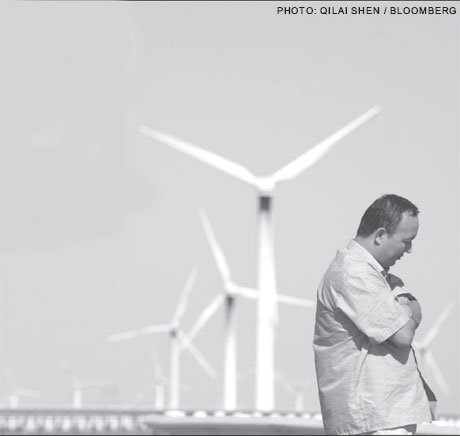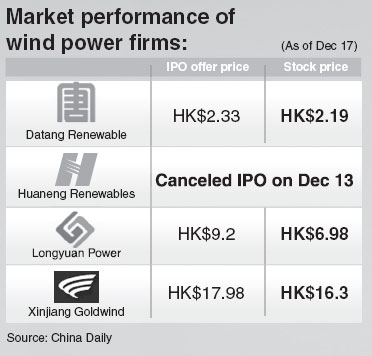Overcapacity dims wind power firms
Updated: 2010-12-18 07:32
By Joy Li(HK Edition)
|
|||||||

But analysts say the long-term industry outlook remains bright
In line with the recent poor performance of its rivals, China Datang Corp Renewable Power Co Ltd, the country's second-largest wind power producer, fell on its trading debut in Hong Kong Friday on worries about overcapacity in the sector.
However, some analysts believe that this is only a short-term problem and that backing at the policy level should provide succor for the industry's long-term outlook.
Datang closed at HK$2.19, more than 6 percent lower than its offer price of HK$2.33. The company's underwhelming debut had been preceded by a flurry of downbeat news from its industry competitors.
Huaneng Renewables Corp cancelled its initial public offering in Hong Kong on December 13, citing unexpected and excessive market volatility. Meanwhile, China Longyuan Power Group Corp, the nation's biggest listed wind power producer by capacity, has dropped 30 percent this year in Hong Kong trading, compared with the 3.4 percent gain in the Hang Seng Index. Xinjiang Goldwind Science & Technology Co has also slumped 9 percent since its trading debut on the local bourse on October 8.
Analysts said investors are concerned about overcapacity in the sector - which has been a problem for a number of years - as well as grid connection problems.
"Investors worry about overcapacity and what will drive the sector's growth," said Lee Yuk-kei, an analyst at Core Pacific-Yamaichi International in Hong Kong.
According to data compiled by the Chinese Wind Energy Association, new capacity in 2009 was 13,803 megawatts (MW), up 124 percent from 2008. New capacity added has doubled every year since 2006, when the figure was only 1,287 MW. At a global level, China has surpassed Germany as the second-largest market for cumulative installation, at 25.8 gigawatts (GW), or 16 percent of the global market, according to the Global Wind Energy Council. The US remains on top in terms of cumulative installation.
The significant surge in new capacity over the past four years has exposed a bottleneck situation, where grid companies are unable to keep pace with the development of wind farms. Brokerage house CLSA estimated in a recent research report that nearly a third of installed turbines in China are not connected to the national grid. Through prior coordination with wind farms, grid connections and transmission systems usually takes one or two years to complete.
"This is a problem that needs to be resolved in the near term," said Rajesh Panjwani, an analyst at CLSA.
In the long run, analysts believe that policy support from the Central Government will prod the industry to grow.
"Domestic demand will determine these companies' growth in the future," said Lee.
Wind power is an important contributor to China's stated goals of reducing carbon intensity by 40 percent by 2020, as well as making 15 percent of its energy renewable by 2020, said CLSA's report.
The annual Central Economic Conference held in Beijing earlier this month released its draft version of the 12th five-year plan for power industry, in which the hydropower capacity target was increased from a previous guidance of 380 GW to 390 GW in 2020. New targets for wind capacity were 100 GW and 180 GW by 2015 and 2020, exceeding the previous guidance of 90 GW and 150 GW respectively.
China Daily

(HK Edition 12/18/2010 page3)